Abstract
Adaptive theory of thermal comfort suggests that people tend to adjust themselves or their environment to achieve thermally comfortable conditions whenever discomfort conditions occurred. In this work, a high-rise residential building was selected to investigate the residents’ adaptive behaviour in the hot humid climate in Malaysia. The objectives are to investigate residents’ preference to use the available adaptive opportunities to achieve thermal comfort, the daily use of the climatic controls and the reasons that influence this usage. A questionnaire survey was distributed to investigate residents’ personal adjustment as well as modifying the indoor thermal environment. The results showed that residents prefer to control their climate conditions using fans and opening windows prior to performing personal adjustment that involves thermoregulation of their bodies. However, when these actions fail to please them, switching on the air-conditioners might be the last choice. In terms of climatic controls, using fans and opening windows were higher in the morning and evening, while they dropped with an increase of the air-conditioners usage during the noontime. In addition, residents find the use of fans and opening windows are enough to be comfortable. Nevertheless, they prefer the availability of air-conditioners for extreme thermal conditions. These findings prove that proper buildings’ design with appropriate passive techniques can provide thermally comfortable conditions without the needs for mechanical conditioning.
Keywords: Adaptive behaviour, Thermal comfort, residential buildings, hot humid climate, Malaysia
Introduction
An adaptive model for thermal comfort depends on the theory of behavioural adaptation of people to stay comfortable (Humphreys, Rijal, & Nicol, 2013). Based on the adaptive theory, occupants’ thermal comfort in a free-running building result from the effects of both stimuli in the surrounding physical environmental and non-physical issues, including individual lifestyles, cultural and socio-economic factors (Liu, Yao, & McCloy, 2012). The adaptive principle can be explained as if any change that produces discomfort occurs such as, people have a tendency to respond in ways that help to restore their comfort. Even though the automatic processes of the human body help to maintain thermal equilibrium with the ambient environment through sweating, shivering etc., the adaptive responses allow occupants to adapt to the environment by means of physiological adaptations (acclimatization), psychological adaptations (expectations), and behavioural adaptations (clothing, windows, fans etc.) (de Dear & Brager, 1998).
According to Humphreys et al. (2013), people adaptation is a two-way procedure between people and the thermal environment by which they became in dynamic balance with the environment surrounding them. People tend to adapt their bodies to their thermal environment by change clothes, position, and perhaps activity. On the other hand, they adapt their thermal environment based on their current needs through adjusting curtains, opening windows, and using heating or cooling systems. Liu et al. (2012) stated that the behavioural adaptation of the occupants is the most type that can be generally observed and consequently studied. This type includes personal adaptation (e.g. putting on/taking off clothing), technological adaptation (e.g. switching on/off air-conditioners or fans) and cultural responses (e.g. taking hot/cold drinks, getting rest during the hottest time of the day, and/or changing the posture). It is highly dependent on the environmental control facilities in terms of availability and variability. In addition, thermal adaptive behaviour is usually linked with naturally ventilated/free-running buildings to achieve comfortable conditions (KC, Rijal, Shukuya, & Yoshida, 2018; Wu et al., 2019). However, it can be noticed also with mechanically conditioned buildings (KC et al., 2018).
Adaptive Opportunities
Occupants’ chances to modify their thermal environment increases with the availability of various environmental controls. These controls, therefore, termed as adaptive opportunities (Liu et al., 2012). Any constraints on these adaptive opportunities might result in failure to achieve comfortable conditions, which can influence occupants to use air-conditioners to restore their comfort.
Clothing and metabolic activity
It was found that when temperature increased, the respondents have succeeded to adapt through clothing and metabolic activity (Indraganti, 2010a; Xu, Li, Zhang, & Shao 2018). Rijal, Humphreys, and Nicol, (2019) noticed that with outdoor air temperature decreases, occupants' clothing insulation increases, while Zhang, Wang, Chen, Zhang, and Meng, (2010) found it decreases linearly with increases of effective temperature. A similar phenomenon was found by Wu et al. (2019) but with operative temperature in which 1 ℃ increase in operative temperature resulted in 0.02clo decrease in clothing insulation. Indraganti (2010b) explained that clothing adaptive actions change the layers of clothing on different parts of the body, which results in an increase or decrease with the air movement around the skin and change the sweating process of the body. However, clothing was found to be restricted by the use of fixed costumes (e.g. office dress) or by socio-cultural practices especially in women (Indraganti, Ooka, Rijal, & Brager, 2014). In addition, he noticed that most of the subjects slowing down their activity during the summer afternoon, while some subjects delay heavy household activities to morning or evening to avoid being discomfort. Furthermore, around 20% of the subjects preferred to lie down during the midday.
Windows and doors
The ease, effectiveness and economy of use are the main reasons that made opening windows one of the most favourite and preferred ways for people worldwide to adapt to the thermal environment (Mishra & Ramgopal, 2013). KC et al. (2018) found that during the summer, occupants open windows to adapt to the indoor environment and achieve comfortable conditions, while it was the second most frequent adaptive behaviour by the workers in office buildings in Indonesia ( Damiati, Zaki, Rijal, & Wonorahardjo, 2016). Although opening windows’ behaviour is usually linked with the indoor temperature, which is the ambient environment of the subject, it was found that it also increases with the outdoor temperature increases (Indraganti, 2010a; Rijal et al., 2019). However, once the outdoor temperature becomes too high, the percentage of opening windows slowly decreased. At this moment, opening windows will introduce more heat from the outdoor environment. Therefore, the occupants adopted by closing the windows (Indraganti, 2010a). Opening windows during the hot summers was found to be high in the morning and low at midday. However, if the indoor temperature is close to the skin temperature with the presence of high humidity, opening windows remains at the maximum percentage. In addition, opening the doors was found to have similar adaptive usage to the windows (Indraganti, 2010a).
Opening windows’ behaviour is not only influenced by the indoor and outdoor temperatures. Several other factors were found to have an influence on opening windows, including sun penetration, safety and security, privacy, suitability, etc (Indraganti, 2010a). Zhang et al. (2007) mentioned that opening windows was mainly for feeling the coolness, get more air movement, and air freshness, while the outdoor noise was the main cause for closing the windows. In addition, the lack of privacy critically affects the adaptive use of openings windows and influences indoor comfort in turn. Indraganti (2010a) stated that the percentage of opened windows was lower when windows opened into a public space. Moreover, safety and unavailability of controls were found to have major obstructions. Furthermore, operation and maintenance of the controls, insects and particularly mosquitoes, stray animals and birds, outdoor noise, and several contextual issues critically obstructed the use of opening windows and influenced the occupant’s adaptive behaviour. In addition, windows orientation also affects their performance and hence operation. Being under direct solar radiation increases the heat build-up in the indoor environment, thus windows are preferred to be opened to help in removing and dissipating the heat (Al-Absi, Abas, & Baharum, 2018).
Fans and Thermal Comfort
The fan is one of the important climate controls that can offer a great adaptive opportunity for users with the presence of high indoor temperature since their usage represents one of the lowest cost environmental controls (Indraganti et al., 2014). Their usage was increased with the increase of the indoor air temperature (KC et al., 2018). Zhang et al. (2010) linked the starting of the change in the proportion of using fans in a naturally ventilated building in China to reaching a high level of effective temperature and as the temperature rises between 25 and 31°C, the increase to the full running was faster. Similarly, Rijal et al. (2019) found that the proportion of using fans increased with the increase of outdoor air temperature. Indraganti et al. (2014) stated that the use of fans with low airspeed had limited effect, while with an airspeed of about 1 m/s, an increase of about 2.7 K in the mean comfort temperature was observed in both naturally ventilated and air-conditioned modes. This is similar to Nicol (2004) who noticed an increase of about 2K in comfort temperature if outdoor temperatures have a wider range. Furthermore, by analysing ASHRAE database, Zhang, Arens, and Pasut, (2011) found that when using ceiling fans, the comfort temperature range is 25.5-28°C, and by using additional personal fans the upper limit for thermal comfort goes up to 30°C.
In addition, climate chamber study revealed that 28-32°C thermal conditions were accepted by subjects when using ceiling fans with air velocity above the limit suggested by ASHRAE of 0.8 m/s ( Huang, Ouyang, Zhu, & Jiang, 2013). They also found the fans were widely accepted by users at home and work through an online survey to investigate their requirements of air movement. This acceptance was attributed to the lower cost associated with using fans, low environmental impacts, and the ability to provide a fresh feeling. Zhai et al. (2013) examined the effect of using personally controlled air movement, by using floor fan, on human thermal comfort at a warm humid environment. The results showed that thermal comfort could be sustained up to 30°C with a relative humidity of 60% without any discomfort from air movement, humidity or eye dryness.
Problem Statement
In a previous work of the authors (Al-Absi & Abas, 2018), the residents were found thermally comfortable and satisfied with the indoor thermal environment in a high-rise residential building in Malaysia without any use of air-conditioning systems. The adaptive behaviour is what provides the residents with the sense of being thermally comfortable in the hot humid climate of Malaysia. As discussed above in the adaptive opportunities, various parameters and environmental controls can be involved in this adaptive behaviour. However, how residents preferred to use these adaptive opportunities within the Malaysian context and which one has the most influence on achieving thermally comfortable condition are required more investigation. This paper aims to investigate the adaptive behaviour of the residents to achieve thermally comfortable conditions in a high-rise residential building in Malaysia.
Research Questions
- How do residents prefer to use the available personal and climatic controls to modify the indoor thermal environment?
- What is the daily use arrangement of the climatic controls to achieve comfortable conditions?
- What are the main reasons that might influence the use of climatic control by residents?
Purpose of the Study
The purpose of the current study is to investigate and understand the adaptive behaviour of the residents and their preference to use the available adaptive opportunities and climatic controls to modify the indoor thermal environment to achieve a satisfactory level of thermal comfort. In addition, the daily use of the climatic controls and the reasons that affect and influence this usage.
Research Methods
A quantitative approach was selected for this work. This paper is part of work that involves field measurements as well as a questionnaire survey to evaluate the perception of the residents for thermal comfort in high-rise residential building. Part of the questionnaire survey was to address the adaptive behaviour of the residents and the use of environmental controls to achieve comfortable conditions. The survey collected data about residents’ behaviour in both; personal adjustment (i.e. clothing, cold drinks, having a bath, going out, etc.), and modifying the indoor thermal environment (i.e. using air-conditioners, fans, opening windows, closing curtains). These data will provide residents’ preference to create a more comfortable thermal environment in their daily life. The residents were asked to indicate the frequency of using adaptive techniques to restore thermal comfort when they express hot and humid indoor conditions. Their answer was a choice on a five-point scale includes “Always, most likely, often, seldom, and very unlikely”. In addition, they were requested to indicate their use of opening windows, fans and air conditioners within the four periods of the day (i.e. morning, afternoon, evening, and night). Finally, they were asked to select the possible reasons that influence their use of climate controls. This approach was used by Wong et al; (2002) in a naturally ventilated building in Singapore.
Case study and sample size
N-Park condominium is a high-rise residential building consists of four blocks with a total number of 988 units. This condominium is situated on the east part of Penang Island, Malaysia. The buildings have a layout of the single-loaded corridor type, which enhances the cross natural ventilation. In addition, these buildings have the recommended orientation in Malaysia, in which the long axis is oriented towards north-south. Furthermore, all the participants on the survey will have equal conditions since all units have the same orientation. Therefore, it was selected as the case study. More details on the building can be found in (Al-Absi & Abas, 2018).
The target was to involve one participant in each unit of the 988 units. Therefore, based on Cochran’s sample size equation (Bartlett, Kotrlik, & Higgins, 2001), a population of 988 will require a sample size of 105. Taking the return rate as 70% (Wafi, 2012), 150 questionnaires were required to be distributed. However, during collecting the questionnaires, the residents’ response was low, and the collected questionnaires were less than the required sample size. Therefore, another 50 questionnaires were distributed. All questionnaires were distributed during the dry season and lasted for almost one month until achieving the required sample size. A total of 116 questionnaires were collected from the distributed questionnaires, and 106 were completed and valid (i.e. return rate 53%).
Findings
In this work, the residents were asked to indicate their preference for the usage of some common adaptive actions once they feel thermally uncomfortable. These adaptive actions running from normal body regulating to extreme actions such as using air-conditioners. They can be grouped into two main categories; personal adjusting (i.e. have a cold drink, have a bath, change clothes, move to other space, rest or sleep and go out) and climate control and adjusting (i.e. use air-conditioners, use fans, open windows and close curtains). Residents answer was on a five-preference scale running from always to very unlikely, which represent their preference to use the adaptive action. The result is shown in Figure 1.
By taking “often” as the central of neutrality in their preference of the adaptive actions, “always” and “most likely” are two positive scales that indicate residents’ tendency to use the action. On the other hand, “seldom” and “very unlikely” are negative scales that show their preference not to use the action. It can be seen that using the fan is the most action preferred by occupants with a percentage of 64.8% for the “always” usage and a total of 80% for both “always” and “most likely”. Improving air movement by using fans in hot and humid conditions is important for thermal comfort (KC et al., 2018). The second highest preferred action is opening windows with 42.3% and 57.7%, followed by having bath 26.9% and 59.6%, reduce or change clothes 23.1% and 54.8%, have cold drink 27.9% and 50% for “always” usage and total of “always” and “most likely” respectively. This is in line with Wu et al. (2019) who found that opining windows, clothing adjustment, and using fan are the main adaptive behaviours of the occupants and that using fans was more helpful and preferred by occupants to maintain comfort.
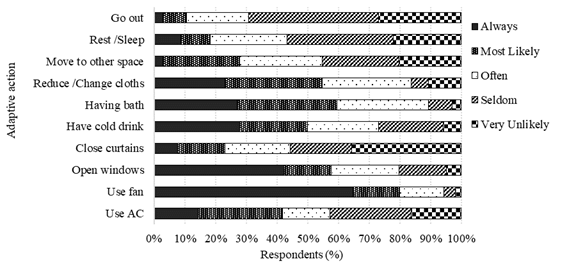
Interestingly, the use of air-conditioners was found to be less preferred with just 14.3% of respondents who chose using it as an “always” behaviour when facing thermally uncomfortable conditions, while another 27.6% of respondents chose it as “most likely”. This may be attributed to the high cost associated with the use of air-conditioners, thus residents use them as the last alternative when other actions fail to satisfy their needs. This is in line with KC et al. (2018) who found that occupants adjusted their clothes prior to the use of any mechanical cooling or heating. Finally, the least favourable actions were moving to other space with a total of 27.9% for both “always” and “most likely”, close curtains (23.1%), rest or sleep (18.3%) and going out (10.6%). Generally, it can be said that the residents prefer to control their climate conditions using fans and opening windows first before they resort to performing personal adjustment that involves thermoregulation of their bodies. However, when these actions fail to please them, switching on the air-conditioner may be the last choice.
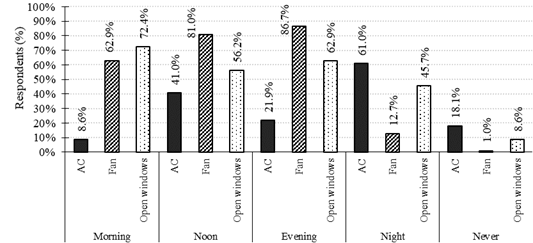
The daily use of the climatic controls was also investigated and is presented in Figure 2. It can be seen noticeably that the highest percentage of the usage is for fans followed by opening windows, then using air-conditioners, which support the above findings. Generally, opening windows is more favourable in the morning (72.4%) when residents seek for fresh air. At this period, the low outdoor air temperature can provide a comfortable condition accompany with the use of fans (62.9%). As they move to the afternoon, opened windows decreases (56.2%), fan usage slightly increases (81%) while air-conditioners usage suddenly increases (41%). As the outdoor temperature increases during this period, percentage of opening windows decreases to prevent the penetration of the hot outdoor air and just depends on the use of fans, whereas others lean towards the use of air-conditioners to feel comfortable. This is also in line with KC et al. (2018) who found windows opening and using fan are increased with the increases of outdoor air temperature above 18 ℃ up to 28 ℃ then the use of air-conditioners is increased with the high increases in outdoor air temperature above 28 ℃. During the evening, since the outdoor air temperature decreases, a slight increase in the proportion of opening windows was observed (62.9%) as well as in using fans (86.7%), whereas the usage of air-conditioners drops to almost half (21.9%). Finally, at night, as the residents return home, they expect to find comfortable conditions similar to those they were in (e.g. workplace, cars, etc.) in order to get a comfortable sleep. A sharp increase in air-conditioners usage was observed (61%) with a sharp drop in using fans (12.7%) and slightly decrease with opening windows (45.7%).
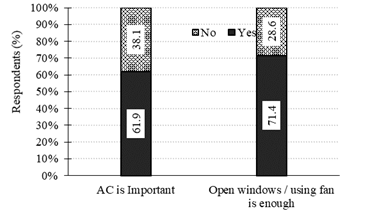
Additionally, Residents were asked direct questions whether the use of air-conditioners is important or not and, in addition, whether the use of fans and opening windows only can satisfy their comfort needs or not. The result is shown in Figure 3. Although 61.9% of the respondents indicated that air-conditioner is important, 71.4% said that the use of fans and opening windows are enough to be comfortable. This is evidence that residents who find using fans and opening windows are enough to feel comfortable, still, consider the availability of air-conditioner is an important alternative. To investigate this more, Table 1 shows cross-frequency matrices of both questions. Almost half of those who said using fans and opening windows are enough to feel comfortable stated that air-conditioner is important.
Looking for the reasons that influence residents to look for having air-conditioner as an important alternative, Figure 4 (left) shows that 70% of the respondents said they use it when the thermal environmental conditions are too hot to be acceptable, while just 17% said they cannot be comfortable without using it and 13% use it just to feel cool for more luxury. This is further evidence that the majority need air-conditioners just to be used for extreme conditions. Furthermore, Figure 04 (right) shows reasons that influence residents to not use an air-conditioner. More than half of respondents (i.e. 51.5%) indicated that they avoid using air-conditioners due to high-cost bills. Another 32.3% said there is no need to use it, while the rest divided between, they do not have due to high-cost installation (9.1%) and they are not allowed to install or use it (7.1%).
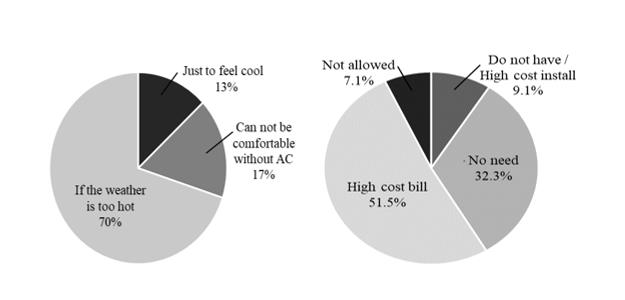
These findings are in line with Brager and Baker (2009). They found that with mixed-mode buildings, a type of buildings that depends on natural ventilation whenever practical but has a mechanical system for cooling, heating or both available, the occupants were more satisfied with the thermal comfort and that satisfaction level increased with the increase of direct control of the occupants. Furthermore, Humphreys et al. (2013) mentioned that the use of these systems as an adaptive technique in mixed-mode buildings occurs whenever the temperature exceeds upper or lower limits. These limits are likely to vary between different cultures and are influenced by the availability and price of the clothes and fuel. A similar result also was found by KC et al. (2018) in which, the residents were preferring the free-running mode rather than the mechanical cooling and heating even with the availability of Home Energy Management Systems. As the earlier finding shows that opening window is the second favourable action to get comfortable conditions. Figure 05 shows reasons that influence residents to close windows, which in turn might affect their comfort. Rain is the highest influential reason with 61.9% votes followed directly by noise (i.e. 60%). This noise may force them to close windows to avoid it. Additionally, more than half of the respondents rated insects as a reason that causes closing windows. Once windows’ design does not include insects’ screen protection, the only available way to avoid the insects and, especially, the mosquito is to close the windows. Night, dust and hot outside come later with 38.1%, 37.1%, and 35.2% respectively. Security and privacy have the same percentage (i.e. 31.4%) followed by smells (27.6%), then health and time not suitable (15.2% and 14.3% respectively) while other problems have just 1.9%. In contrast, those who said that there are no problems were just 1.9%.
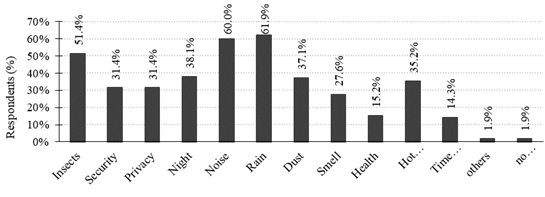
Conclusion
The current study was conducted to investigate the adaptive behaviour of the residents in a high-rise residential building in Malaysia. The case study was selected carefully to ensure the best cross natural ventilation and equal conditions for all participants. The findings of this work are:
- The most preferable adaptive action by residents was using fans followed by opening windows, having a bath, reduce or change clothes, having a cold drink and use air-conditioners while the less preferable adaptive actions were moving to other space, close curtains, rest or sleep and going out.
- The percentage of using fans and opening windows were higher in the morning and evening while during the noontime (i.e. hot outdoor temperature) and the night time (i.e. looking for comfortable sleep), this percentage dropped with an increase for the percentage of the air-conditioner usage.
- Residents consider the availability of air-conditioner is an important alternative even though they find the use of fans and opening windows are enough to feel comfortable.
- The most reason that influences residents to use air-conditioner was the extremely hot weather, while the reason that restricted its use was the high-cost bills.
- Windows closing was mainly influenced by the rain, outdoor noise and insects followed by night time, dust, hot outdoor weather, security, privacy and smell.
To conclude, it can be said that the residents’ adaptive behaviour was found to start with controlling the climate conditions with low energy actions (i.e. fans and windows opening) followed by personal adjustment (i.e. cold drink, bath, clothing, etc.). The final step will be using air-conditioners if the previous actions failed to achieve comfortable condition. These findings prove that proper design of buildings with appropriate passive design techniques can provide thermally comfortable conditions for the occupants without the needs to use mechanical conditioning, which must be taken to consideration by buildings’ architects and developers. However, air-conditioning systems must be considered during the design process to avoid the random installation by occupants during the post-occupancy.
Acknowledgments
The authors would like to thank Department of Architecture, Faculty of Engineering, Sana’a University, and School of Housing, Building and Planning, Universiti Sains Malaysia for the financial support of this research through UnFRGS (203/PPBGN/6711516) grant.
References
Al-Absi, Z. A. A. S., Abas, N. F., & Baharum, F. (2018). Windows Operation for Residents’ Thermal Comfort in Naturally Ventilated Residential Building in Malaysia. International Transaction Journal of Engineering, Management, & Applied Sciences & Technologies, 9(3), 173–183.
Al-Absi, Z. A., & Abas, N. F. (2018). Subjective assessment of thermal comfort for residents in naturally ventilated residential building in Malaysia. In IOP Conference Series: Materials Science and Engineering (Vol. 401, p. 12009). IOP Publishing. DOI:
Bartlett, J., Kotrlik, J., & Higgins, C. (2001). Organizational research: Determining appropriate sample size in survey research. Information Technology, Learning, and Performance Journal, 19(1), 43–50.
Brager, G. S., & Baker, L. (2009). Occupant satisfaction in mixed-mode buildings. Building Research and Information, 37(4), 369–380. DOI:
Damiati, S. A., Zaki, S. A., Rijal, H. B., & Wonorahardjo, S. (2016). Field study on adaptive thermal comfort in office buildings in Malaysia, Indonesia, Singapore, and Japan during hot and humid season. Building and Environment, 109, 208–223. DOI:
De Dear, R., & Brager, G. S. (1998). Developing an Adaptive Model of Thermal Comfort and Preference. ASHRAE Transactions, 104(1), 145–167.
Huang, L., Ouyang, Q., Zhu, Y., & Jiang, L. (2013). A study about the demand for air movement in warm environment. Building and Environment, 61, 27–33. DOI:
Humphreys, M. A., Rijal, H. B., & Nicol, J. F. (2013). Updating the adaptive relation between climate and comfort indoors; new insights and an extended database. Building and Environment, 63, 40–55. DOI:
Indraganti, M. (2010a). Adaptive use of natural ventilation for thermal comfort in Indian apartments. Building and Environment, 45(6), 1490–1507. DOI:
Indraganti, M. (2010b). Thermal comfort in naturally ventilated apartments in summer: Findings from a field study in Hyderabad, India. Applied Energy, 87(3), 866–883. DOI: 10.1016/ j.apenergy.2009.08.042
Indraganti, M., Ooka, R., Rijal, H. B., & Brager, G. S. (2014). Adaptive model of thermal comfort for offices in hot and humid climates of India. Building and Environment, 74, 39–53. DOI:
KC, R., Rijal, H. B., Shukuya, M., & Yoshida, K. (2018). An in-situ study on occupants’ behaviors for adaptive thermal comfort in a Japanese HEMS condominium. Journal of Building Engineering, 19, 402–411. DOI:
Liu, J., Yao, R., & McCloy, R. (2012). A method to weight three categories of adaptive thermal comfort. Energy and Buildings, 47, 312–320. DOI:
Mishra, A. K., & Ramgopal, M. (2013). Field studies on human thermal comfort - An overview. Building and Environment, 64, 94–106. DOI:
Nicol, F. (2004). Adaptive thermal comfort standards in the hot–humid tropics. Energy and Buildings, 36(7), 628–637. DOI:
Rijal, H. B., Humphreys, M. A., & Nicol, J. F. (2019). Adaptive model and the adaptive mechanisms for thermal comfort in Japanese dwellings. Energy and Buildings, 109371. DOI:
Wafi, S. R. S. (2012). Thermal Comfort of Students’ Accommodations in Universiti Sains Malaysia. (PhD thesis). Universiti Sains Malaysia.
Wong, N. H., Feriadi, H., Lim, P. Y., Tham, K. W., Sekhar, C., & Cheong, K. W. (2002). Thermal comfort evaluation of naturally ventilated public housing in Singapore. Building and Environment, 37(12), 1267–1277. DOI:
Wu, Z., Li, N., Wargocki, P., Peng, J., Li, J., & Cui, H. (2019). Adaptive thermal comfort in naturally ventilated dormitory buildings in Changsha, China. Energy and Buildings, 186, 56–70. DOI:
Xu, C., Li, S., Zhang, X., & Shao, S. (2018). Thermal comfort and thermal adaptive behaviours in traditional dwellings: A case study in Nanjing, China. Building and Environment, 142(May), 153–170. DOI:
Zhai, Y., Zhang, H., Zhang, Y., Pasut, W., Arens, E., & Meng, Q. (2013). Comfort under personally controlled air movement in warm and humid environments. Building and Environment, 65, 109–117. DOI:
Zhang, H., Arens, E., Fard, S. A., Huizenga, C., Paliaga, G., Brager, G., & Zagreus, L. (2007). Air movement preferences observed in office buildings. International Journal of Biometeorology, 51(5), 349–360. DOI:
Zhang, H., Arens, E., & Pasut, W. (2011). Air temperature thresholds for indoor comfort and perceived air quality. Building Research & Information, 39(2), 134–144. DOI:
Zhang, Y., Wang, J., Chen, H., Zhang, J., & Meng, Q. (2010). Thermal comfort in naturally ventilated buildings in hot-humid area of China. Building and Environment, 45(11), 2562–2570. DOI:
Copyright information

This work is licensed under a Creative Commons Attribution-NonCommercial-NoDerivatives 4.0 International License.
About this article
Publication Date
26 December 2017
Article Doi
eBook ISBN
978-1-80296-950-4
Publisher
Future Academy
Volume
2
Print ISBN (optional)
-
Edition Number
1st Edition
Pages
1-882
Subjects
Technology, smart cities, digital construction, industrial revolution 4.0, wellbeing & social resilience, economic resilience, environmental resilience
Cite this article as:
Al-Absi*, Z. A., & Abas, N. F. (2017). Adaptive Behavior Of Residents For Thermal Comfort In High-Rise Residential Building, Malaysia. In P. A. J. Wahid, P. I. D. A. Aziz Abdul Samad, P. D. S. Sheikh Ahmad, & A. P. D. P. Pujinda (Eds.), Carving The Future Built Environment: Environmental, Economic And Social Resilience, vol 2. European Proceedings of Multidisciplinary Sciences (pp. 404-414). Future Academy. https://doi.org/10.15405/epms.2019.12.39
